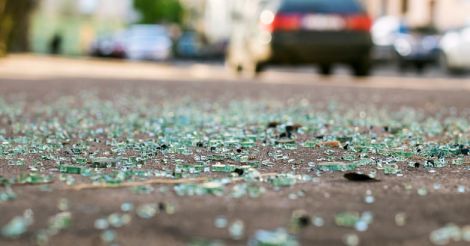Every year, road accidents kill or permanently disable more than 36,000 individuals in Kerala - a staggering number for a total state population of just 35 million. This number is greater than the newly diagnosed cases of cancer; and tragically, more than half of these are healthy people between 20-55 years of age.
Unfortunately, deaths and disability from road accidents are not yet regarded as a public health problem in India; many people dismiss it as an act of fate or the natural outcome of limited infrastructure, faulty law-enforcement and overcrowding. However, barring an unavoidable few such as those that follow a collapsed bridge or burst tyre, most accidents involve a human behavioral element – which is the main focus of this article.
Read: Everyday Health | Love Kerala food? Here's a diet plan tailored for you
Road deaths and injuries are as much a preventable public health problem, as Polio, Malaria, or Dengue. Recognizing this, the UN and WHO announced 2011-2020 as the decade of action for road safety.
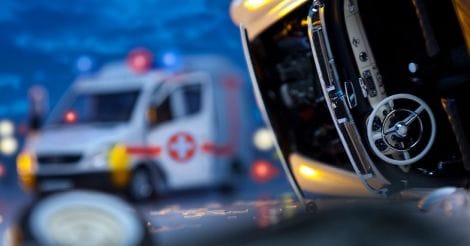
What is primary prevention of Road Accidents?
In India, most of the healthcare-related work done on the subject of road accidents is aimed at managing the complications: that is, damage control after the event has occurred. Improvements have occurred in ambulance services, first aid to the victim, emergency hospital care and trauma surgery – but these are secondary and tertiary prevention measures. While these steps are no doubt essential, they still cannot prevent a large chunk of the deaths and disability from road accidents. This is because some of the cases are fatal to start with, or impart such severe injury from which reasonable recovery is not possible in spite of the best treatment available.
Read: Everyday Health | Transgenders – there is much to know before judging!
Primary prevention, in public health terms, is an intervention that prevents an event from occurring, while secondary and tertiary prevention refer to measures taken after the event has already occurred. Diphtheria vaccination is the classic example of primary prevention: vaccination is easier, cheaper, and much less morbid than the disease itself.
The same logic applies to road accidents: prevention is better than cure.
Aren’t accidents a fault of the system?
Many people assume that accidents in India are caused by bad road conditions, and that by building better roads the accident rate will come down. This is not wholly true. If bad roads caused accidents, then, logically, most of us would not be alive today. It is when bad roads combine with bad behavior that most accidents happen.
Read: Everyday health | Learn these 6 first-aid tips, be a lifesaver [ video]
Hazardous Road Behavior plays an important part in causing road accidents, much like smoking leads to heart disease and inadequate mosquito control leads to malaria. It stems from lack of basic knowledge of biology and physics, faulty learning of driving skills, a situation made worse by a generalized paucity of civic sense.
Is there a simple way to prevent road accidents?
Conceptually, a road accident is the tragic outcome of several suboptimal conditions existing singly or in combination. This principle can be easily understood from the following simple example.
Read: Everyday Health | Google vs doctor: why Internet self-diagnosis is a bad idea
Let us imagine someone washing a porcelain dinner plate at the kitchen sink. Chances are that he will be able to complete the task without incident. But when the process is repeated enough number of times under different conditions, occasionally the plate will slip from his hands, fall and break, even though he had no intention to do so.
If we critically analyze the two scenarios, comparing the occasions when the plate broke, to those when it didn’t, a pattern will gradually emerge. Every time the plate broke, we will be able to identify a suboptimal condition. For example:
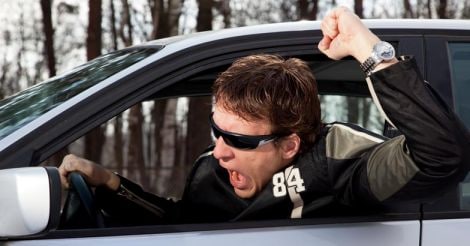
1. The person might have applied too much soap, and it became slippery
2. The lighting in the work area might not have been good
3. The person might not have washed plates before
4. The person might have been in a hurry to finish that work and do something else
5. The person might have been mentally distraught and washed absent-mindedly or with vengeance
6. The person might have been distracted either by conversation or by the television while washing the plate
7. The person might not have been familiar with the washing area and its controls
8. The person might have been tired after washing too many plates
9. The person might have been sleepy or drunk
10. The person might have poor eyesight or other physical limitation
Let us now look at the corollary: every time a suboptimal condition is present, the risk of an accident increases. The more the number of suboptimal conditions present, the greater is the risk of the plate breaking. For example, when the person was too sleepy, forgot to turn on the light, and poured on too much soap in a hurry, the plate would be much more likely to slip from his hand and break.
Read: Everyday Health | 16 tips for a healthy, and cool, summer
The breaking of a dinner plate is a simple incident. But the principles underlying a road accident (obviously a much more complex outcome with many more variables involved) are the same: every time there is a suboptimal situation, the probability of accident increases, although it doesn’t happen each time. In fact, this example holds true for many adverse outcomes we encounter in life.
Poor town-planning, congestion, unscientifically designed and pot-holed roads are part of living in India: these can be termed constant factors, which affect every road user. Road conditions are not something that we can easily change as individuals.
A more practical approach is to focus instead on those factors that we as individual road users have the power to change – we can call them variable factors. The following section is about identifying those suboptimal conditions, also termed hazardous road behaviors. These can be taught to and adopted by everyone, and will greatly decrease the risk of injury or death on the road. Input for this article has come from numerous worldwide experts on road safety, along with a detailed analysis of published research papers.
Read: Everyday Health | Medical hoaxes: if it sounds too good to be true, it probably is
What are the specific steps each one of us can take to reduce risk of death on the road?
1. Be acutely aware of the dangers of the road.
Pedestrians and two-wheelers are termed vulnerable road users - they make up two-thirds of the 4200 people who get killed on Kerala roads every year. These two categories of people are advised to exercise extreme caution when using the road. In fact, some experts advise avoiding the road unless absolutely necessary.
Going back to the example above, this extreme level of caution is similar to the situation while handling a porcelain plate, the person being constantly aware that it is easy to break it. In fact, if the person had actively thought of the possibility of breakage each time he washed the plate, the risk of breakage would be almost zero.
Read: Everyday Health | Brain death: When is someone really dead?
Imagine the scenario when a distracted pedestrian who is talking on a mobile phone, is trying to cross a crowded road in a hurry to catch a bus that has just stopped at the bus stop across the street. Now add a motorcyclist, speeding and weaving dangerously along the same road, oblivious of the road congestion and desperate to reach his office on time after starting out late. This is a perfect setting for an accident.
While it may seem like a routine news report in the papers to the rest of us, each of these incidents represents an abrupt and tragic loss for a family out there whose life would never be the same again.
2. Do not use the road to make up time.
The logic is downright simple: if we wish to reach on time, we must start early. People who have the habit of starting late and speeding on the road to make up time are a risk to themselves as well as to other road users. They ignore safety rules on the road that they might otherwise have followed, taking more and more risks and eventually causing tragic accidents. On critical analysis, failing to budget enough time for travel is a major underlying cause for many of the accidents that happen in India.
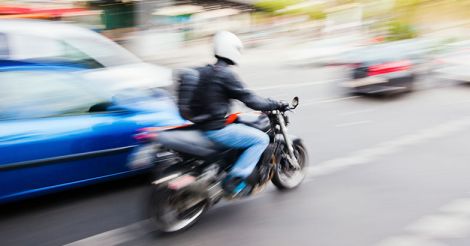
Read: Everyday Health | Who said death has to be unpleasant? Do these 16 things now
In India, it would seem that most people are in a hurry, whether they are using the road, entering the lift in a building or even when boarding an empty train. Originating from faulty time-management or total lack of it, hurrying is mostly a subconscious behavior that is influenced by mob psychology. While in a crowd, we tend to do what most others do, without cerebral-level thinking. Our level of morality transiently declines due to the anonymity that the crowded road provides us. This translates into surprisingly selfish behaviors, lack of courtesy to other road users, and dangerous maneuvering, frequently putting others’ life at risk.
Several two-wheelers, city-buses and mini-trucks (‘tippers’) engage in this dangerous road behavior even for routine commutes, rushing at breakneck speed through crowded roads. (Some city-buses even compete with each other, breaking traffic rules and endangering the lives of other road users- all for a few extra rupees) Applying basic mathematics, one can see that the time saved by hurrying at a risky 60 km per hour (compared to a much safer 30 km per hour) for a five-kilometre commute is only five minutes!
There being as many as 1440 minutes in a day, it makes better sense for the commuter to start five or ten minutes early instead. Likewise, city-buses would cause fewer accidents if only they followed a more relaxed schedule of stops and had less aggressive drivers.
It is also helpful to revise our high-school physics lessons here: the extent of injuries caused during an accident is determined by the kinetic energy of the vehicle while traveling.
Kinetic energy = ½ (Mass) x (Velocity)2 [velocity squared]
Thus, if we double the speed, we quadruple our kinetic energy!
Read: Everyday health | Noise kills: this is scarier than you thought
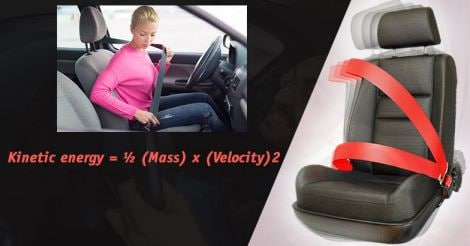
Studies have shown that if a car hits a pedestrian at 65 kmph, he is 5 times more likely to die than when the collision happens at 40 kmph.
Getting road users to change this perpetually hurried behavior, display more civic sense and pay attention to time-management by budgeting enough time for safe travel will prevent many accidents.
Many would argue that Indian roads are more crowded than the western nations, and that these are inevitable changes in road user-behaviour. Interestingly, crowding alone need not lead to irrational hurry on the road, as evidenced by the courteous road behaviour and exemplary civic sense that can be observed on even the busiest roads of Colombo, Sri Lanka.
2. Avoid dangerous overtaking
Hurrying leads to overtaking, especially on single lane roads. Done often needlessly in suboptimal conditions, overtaking is a major cause of accidents. Many head-on collisions with multiple casualties are the result of faulty overtaking.
Overtaking must be done only when there is complete visibility of the road ahead, and never at a curve. On congested roads, large blind spots can prevent us from seeing pedestrians and oncoming vehicles on the road, making overtaking more hazardous.
Conversely, if we drive too slowly or absent-mindedly blocking the road, we can indirectly cause accidents by other frustrated people trying to overtake us in large numbers.
3. Never compromise on safety equipment
From an evolutionary standpoint, all animals have the ability to recover from injuries sustained by normal locomotion. A cheetah can survive a fall at speeds over 35 kmph, but a human being is built for walking and running at much lower speeds. Our bodies have not yet evolved to stay safe while being transported at higher speeds by modern technology. For example, a motorcycle can transport a person at 70 km per hour, but the body cannot survive a fall at that speed. (In fact, applying the laws of physics, falling off a bike at that speed will produce the same injuries as leaping off the seventh floor of a tall building onto concrete ground) Protective equipment therefore must be worn while traveling at speeds greater than man’s average running speed - and that includes cycling.

Read: Everyday Health | Going for a lab test? You need to read this first
Seat belts protect the occupants of a car from smashing their heads on the windshield as the human body transforms into a fast-moving projectile inside an abruptly stopped vehicle, at the moment of impact during a collision.
A two-wheeler is precariously balanced on two wheels with minimal road contact. It can therefore topple easily, even at the fault of someone else. The first body-part to hit the ground is often the head because it has the highest density. The brain is extremely fragile - it has the consistency of jelly. If broken, it cannot be stitched back together - unlike broken skin or bone. In contrast to liver cells, brain cells cannot regenerate; brain damage is therefore permanent.
During a fall, the helmet protects the head, much like our hand will protect a falling egg from shattering into pieces.
There are two important mechanisms by which the helmet protects the head.
1. It decreases the force generated on impact, by reducing the deceleration.
2. It distributes this force over a wider area, thus reducing the pressure applied on the skull.
The first mechanism is based on the following physics formula:
Force on impact (F) = Mass x Deceleration
Deceleration is the rate at which an object slows down. The velocity of the falling head reduces to zero as it hits the ground. The faster this happens, the greater the deceleration and impact force.
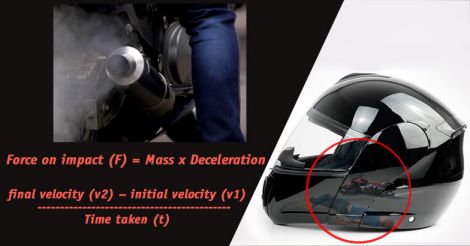
Deceleration is calculated by:
final velocity (v2) – initial velocity (v1)
-------------------------------------------
Time taken (t)
The helmet’s foam cushion is designed to crush partially on impact, thereby letting the velocity become zero more gradually, thus increasing the time taken (t). The same principle applies when a person lands on a haystack while falling – the initial velocity (v1) takes more time to reach zero, again reducing deceleration.
Thus, deceleration injury is worst when the head hits a hard object directly and the velocity reduces to zero in an instant - which is what happens without a helmet.
The second mechanism is based on the following physics formula:
Pressure = Force/Surface area
It is common knowledge that even a small force, when applied over a tiny area, transforms into a large pressure. For example, a flat-headed pin can be easily driven into wood using just our thumb because the area at the tip of the pin is miniscule.
When the naked head hits a hard ground, due to its rather spherical shape, the area of impact of the skull with the ground is tiny - only about 5-10 sq cm. Applying the formula, even a small force on impact thus transforms into a large pressure that will either crack the skull or cause closed brain injury.
But when wearing the helmet, the area of impact is larger: about 300 sq cm. The shell of the helmet spreads the force of impact over a much wider area. This reduces the pressure applied on the skull by several-fold, compared to the same fall occurring without a helmet.
Thus, the helmet is not to be seen as a tool to prevent harassment by the police, but as a life-saving travel accessory. Needless to say, the pillion rider also should wear one, for his own safety. Likewise, the people who sit in the backseat of a car also should wear a seatbelt, regardless of what the law mandates.
A selected few from a long list of other hazardous road behaviors:
1. Operating a vehicle without turning on the lights at night: A vehicle’s lights are not only there to help us see others, but also helps other road users see us.
2. Walking on the road at night wearing dark clothes: In the dark, drivers inside vehicles will not be able to see us walking on the road in black outfits because of lack of contrast with the surroundings. Wearing white or yellow clothes ensures better visibility.
3. Traveling at odd hours: It can be risky to drive late at night or in the early hours of the morning. It is possible to sleep off or become the victim of an accident caused by another driver who was either drunk or who fell asleep at the wheel, or who decided to break all traffic rules under the cover of the night.
4. Driving when sleepy or fatigued: Numerous accidents have happened due to driver fatigue, killing several passengers as well as other road users after the driver fell asleep while driving. If sleepy, it is better to park the car safely and take a quick nap rather than risk continuing to drive.
5. Drinking and driving: Alcohol, in any form, whether it is beer or hard liquor - prolongs our reaction time in an emergency situation, even though at baseline the person may not feel any different. A ‘peg’ of alcohol (60 ml) delays our reaction time by 40%.

Let us do some math again. A vehicle traveling at 80 km per hour covers 72 feet in just one second. Thus, a delay of even one second in applying the brake can result in a devastatingly severe injury due to higher speed at collision. A major study published in The Lancet in 2015 showed that in developing countries, the risk of accidents and deaths was high among alcohol users.
6. Mobile phone use while driving: The process of vision does not take place inside the eye. It occurs when the occipital lobe of our brain processes the images sent up from our retina.
While driving, if we talk on a mobile phone even using a handsfree set, it decreases the transmission of images from our eye to the brain. Therefore we become unable to see the whole picture that is in front of us, in effect missing a few portions of the actual picture. ('We may be looking, but not seeing'). Other distracting activity such as searching for directions while driving also results in such functional blindness.
Summary:
Summing up, it is wrong to assume that accidents are a fault of the roads alone. Human behavior on the road needs to change, starting with identifying, and then, eliminating Hazardous Road Behaviours. For that to be possible, sustained education needs to happen, much like the anti-smoking campaign.
In addition to building awareness on this topic, enforcing harsh penalties for dangerous road behavior will go a long way in protecting the lives of innocent road users.
Further reading
1. Kerala Police data on Road accidents - Click here
2. UN/WHO Decade for road safety action plan - Click here
(The author is a senior consultant gastroenterologist and deputy medical director, Sunrise group of hospitals)

























